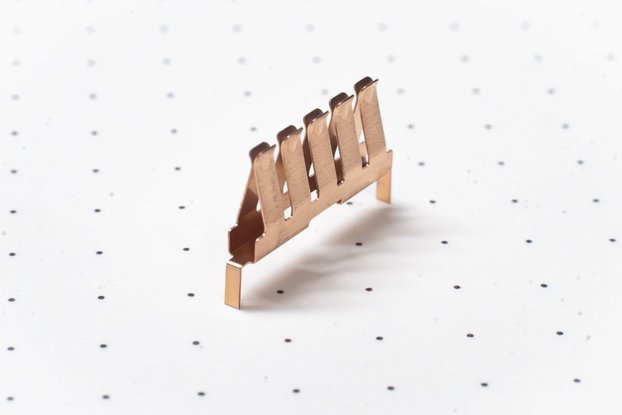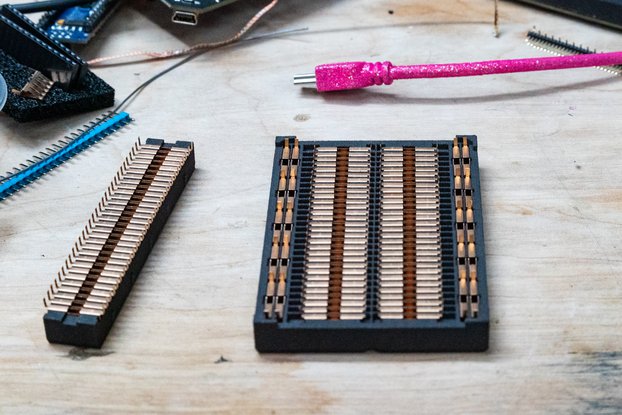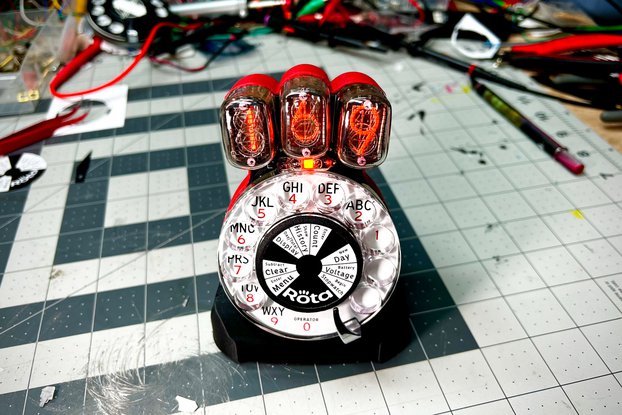a jumperless (solderless) breadboard
Designed by Architeuthis Flux in United States of America
Buy with confidence.
Our Tindie Guarantee protects your purchase from fraud. Learn More
Jumperless a jumperless breadboard What is it? Using a bunch of analog crosspoint switches wired together into one bigger switch, this breadboard makes real, hardware connections between any points o…
Read More…Using a bunch of analog crosspoint switches wired together into one bigger switch, this breadboard makes real, hardware connections between any points on the board or the Arduino Nano header at the top via software command, instead of needing to use jumper wires.
Jumperless also has a ton of voltage/current sensing so the RGB LEDs underneath each row can show a ton of information about what's going on with your circuit. 2 buffered high-current DACs (one 0-5V and one ±8V), 4 buffered and level-shifted 12-bit ADCs (3 are 0-5V and 1 for ±8V), 2 INA219 current and voltage measurement ICs, and 5 GPIO to simulate digital signals that can be routed to anywhere on the breadboard or the Arduino Nano header (also broken out to the top left corner for doing other things.)
Use it to probe the pins on an unknown IC, or for some automated fuzzing, or to read/write EEPROM chips, or to help guide you through converting a schematic to a real circuit, or do whatever the hell you want with it.
The connections are real and fully analog (-8V to +8V, up to around 1 MHz before signal quality starts to degrade) instead of cheating with some measure-then-simulate setup, although you can do that too if you want to simulate a memristor or to send jumpers over the internet.
I include a probe kit in the box so you can assemble your own. If you're not comfortable with soldering, let me know and I will assemble it for you.
You can also make connections using Wokwi while running the Jumperless Wokwi Bridge app on your computer. It's command line interface that automatically pulls any changes you make to your Wokwi project (both connections and Arduino code) and sends them to the Jumperless. It also checks for firmware updates and will automatically keep your Jumperless firmware up to date.
The commands are really simple and human readable so you can even just type in connections via any serial terminal you like. For example, sending
f (to tell the Jumperless to accept connections)
1-2, 5-6, SUPPLY_5V-8,
over any serial monitor you like would connect row 1 to row 2, etc.
You can even have the Arduino Serial.print() that string (you don't even need an between f and the connections, a space will work too so "f 1-2,2-4,") the Jumperless will make those connections.
Here's a demo of an Arduino sending connections to the Jumperless over serial
It also passes through all the serial communications to and from the Jumperless so you can use the text-based menus to do things like running the wave generators, measuring current/voltage, and looking debug output on the Jumperless directly at the same time.
Jumperless shows up as 2 USB devices, so you can connect the second one to the Arduino Nano and flash the firmware and communicate via Serial through one USB cable as if they were both plugged in separately. You can also route the UART Tx and Rx lines anywhere and talk to things just like you would with one of those cheap USB-Serial boards. More details about that here.

The Jumperless is controlled by an RP2040 and can be programmed exactly like a Raspberry Pi Pico. I spend every waking second of my life working on the firmware so there will be frequent updates. There are prebuilt UF2 files on Github under Releases, so whenever there's an update, just hold the USB BOOT button while plugging it into your computer, then drag that UF2 file into the drive that pops up and you're good to go.
The whole thing is open source so you can also edit/fix the firmware however you like (and please submit a pull request on Github to share your fixes)
It uses MCP4822 2 channel SPI DAC, which is fast enough to make waveforms well above 40KHz.
The DACs are buffered through an LM272D High Power (1A) op amp. The +-8V DAC output is hardwired to one of the 2 INA219 current/voltage sensors so you can always see how much current is being drawn. The other INA219 is routable anywhere on the breadboard.
If you blow something up on this board for whatever reason, just let me know. I'd be happy to repair/replace it for you for free or walk you through the repair and send you the parts.
What's especially relevant for you guys are the DACs and ADCs. One output of the MCP4822 12-bit SPI DAC is level shifted with a beefy power op amp to +-8V and the other to 0-5V.
The ADCs are the built in (12-bit, 500Ksps) ones from an RP2040, double buffered and level shifted to the 0-3.3V the RP2040 can handle. One of them is shifted to read +-8V, the other 3 are 0-5V.
Or another way to use this would be to sequence modular synth connections or guitar pedals with a control signal or something. Like having patch cables that can be swapped around really fast (it takes ~30 microseconds to make/break connections) and do it programmatically. The connections can handle +-8.5V and seem to be good up to 1MHz until the capacitance of the breadboard itself starts to matter (the switches themselves are rated to 50MHz at 3dB rolloff), so it should handle most signal levels.
The switch on the upper left controls the rail voltages, if you look at the side of the building in the logo, you'll see the settings; +-8V, 5V, and 3.3V. If you set it to +-8V, the top positive rail will be ~+8V and the bottom positive rail will be ~-8V. Otherwise, they will both be the same, either 5V or 3.3V. The negative rails are permanently tied to Ground.
Although Jumperless is made with love, it's not a precision instrument, the connections it makes go through CH446Q crosspoint switches and do have some resistance, about 85 Ohms total for a connection and resistance is matched to within 5 ohms for every connection. It sounds like a lot, but in practice it doesn't seem to have a noticeable effect on most circuits that one would build on a breadboard. It also sort of acts like a current limit to keep you from accidentally frying stuff.
If you want to get the resistance lower, you can make redundant connections to halve it each time (running that 75 Ohms in parallel with another 75 Ohms.)
Worst case, it's still a breadboard and although it's called Jumperless, that's not a rule. You can run jumpers the old fashioned way.
There's also a maximum rated current for the crosspoint switches, it says 15mA per connection and 100mA per chip. I have run 200mA through a single connection for a few minutes without issues, but of course be aware of that.
I'm giving you permission to take the Absolute Maximum Ratings for the CH446Q with a grain of salt. If you fry one, I'll repair it for free. The chips are super easy to swap out with a hot air gun. If you think you're going to fry these chips regularly (it's actually surprisingly hard to do), and have access to a hot air station, let me know when you place the order and I'll throw in a few extra CH446Qs in the box so you can replace them yourself.
If you have some time to wait for the next version, Jumperless V5 is in pre-launch on Crowd Supply, they'll probably ship sometime around March 2025.
No country selected, please select your country to see shipping options.
No rates are available for shipping to .
Enter your email address if you'd like to be notified when Jumperless can be shipped to you:
Thanks! We'll let you know when the seller adds shipping rates for your country.
| Shipping Rate | Tracked | Ships From | First Item | Additional Items |
|---|---|---|---|---|
|
:
|
Product: (5.00)
Documentation: (4.86)
Shipping: (5.00)
Communication: (4.86)
Mirvin | Dec. 12, 2025
Virginia | March 20, 2024
Robert | Jan. 14, 2024
Adam | Jan. 4, 2024
Filippus | Dec. 24, 2023
Philip | Nov. 22, 2023
Adam | Nov. 15, 2023
Buy with confidence.
Our Tindie Guarantee protects your purchase from fraud. Learn More

$20.00
Free Shipping!

$3.50
Free Shipping!

$12.00
Free Shipping!

$150.00
Free Shipping!

$45.00
Free Shipping!
By clicking Register, you confirm that you accept our Terms & Conditions
We recognize our top users by making them a Tindarian. Tindarians have access to secret & unreleased features.
We look for the most active & best members of the Tindie community, and invite them to join. There isn't a selection process or form to fill out. The only way to become a Tindarian is by being a nice & active member of the Tindie community!
